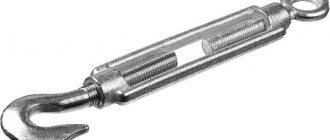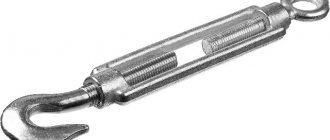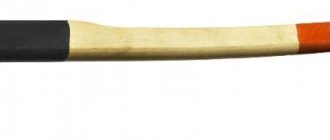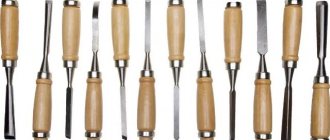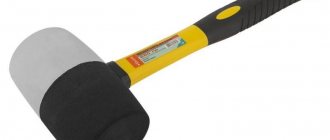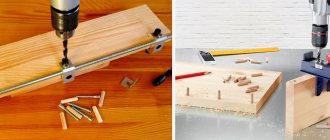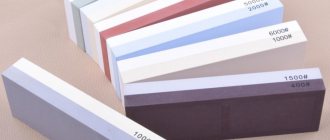Diamond glass cutter. tool types
Since we started talking about edges, it’s time to explain what they are. Based on the number of working edges, there are two types of glass cutters. More difficult to use, but long-lasting. This is a tool with a tetrahedral diamond pyramid, which is soldered into a square holder. 2nd type. more suitable for the beginning glassmaker and is equipped with a curved cut diamond, which is fixed in a round base. This option is easier to use, since the chip is in the plane with the main axis of the device, and the master intuitively understands how glass is cut with a diamond glass cutter of this type.
With a tetrahedral diamond, things are more difficult. The cutter has markings for 4 positions, in other words, it indicates the orientation of the working edge, which will later prevent you from getting confused when turning the ground edge. Another feature that is more difficult for a novice owner is the process of use itself. The cutter is not in the axis of the tool, but at an angle of 200 degrees, as it should, it needs to be held slightly differently, if it seems at first glance. From here, at first you can spoil a lot of glass.
Glass cutters differ in the size of the stone, due to the thickness of the glass planned for cutting. The smallest diamonds (up to 0.05 carats) cut only thin-sheet products (up to 5 mm). But glass 6-10 mm wide can only be cut perfectly by a diamond larger than 0.11 carats. The price of “precious” glass cutters is essentially not as prohibitive as it seems, but significantly more than that of ordinary roller tools. An artificial stone of small mass for thin-sheet glass will determine the cost in the region of 10, but a larger and more natural stone will cost 30 in the instrument
Varieties
Experienced craftsmen recommend using three main types of glass cutters, with which you can easily cut glass to the required size, even at home.
Roller
Quite a popular model, characterized by ease of use. A roller glass cutter is often chosen by beginners, as it is easy to use. In addition, such a tool is cheap because there are no diamond stones in its design.
Structurally, the glass cutter consists of a roller part and a handle. To make the roller, special hard alloys are used; the diameter of the element is 5 mm.
But the working life of such a tool is limited - it is enough for three and a half to four hundred meters of glass material. But since the price is very reasonable, you can purchase a new tool at any time. In addition, the kit includes several replaceable roller elements, so you won’t have to change the purchased tool for quite a long time.
Diamond
Another common, effective and popular glass cutter is a diamond cutter. This option is perfect for both professionals and inexperienced glass carvers.
Let's figure out how to cut glass using a diamond glass cutter. Let us immediately note that during the learning process you will ruin more than a dozen glasses, but all your expectations will be met as soon as you master the technique of using a diamond glass cutter.
Diamond glass cutter
The tool consists of a handle and a working head with a diamond element, which can be pyramidal or beveled. You need to know everything about this feature, since shaped differences in the heads affect the principle of operation. For example, cutting glass with a pyramid-shaped head is much more difficult - this requires a developed, almost “musical” ear. Let's see how to properly cut glass with this glass cutter. During operation, the diamond moves across the glass surface and produces a sound of a certain frequency. When the sound is “wrong,” this confirms that the movement of the diamond element is abnormal, and the glass chip is likely to be defective. To cut the desired shape correctly, beginners use a glass cutter that has a beveled head.
In such an instrument, the stone can be artificial or real, and this difference affects the cost. But there is one more feature here - with a real diamond you will cut glass of a centimeter thickness, but an artificial one will only be enough for 5 mm. And the operational period of such samples is different - a real diamond will cut from ten to fifteen kilometers of glass, while an artificial one will end its operation after the fifth kilometer.
Oil
This version of the glass cutter is a modification of the tool with a roller head. The handle contains a small reservoir into which lubricant is poured. During the cutting process, it is constantly supplied to the roller and glass surface, significantly reducing friction and improving the quality of scratched lines, ensuring long-term performance of the tool. Ultimately, the operational period of an oil glass cutter, compared to a simple roller cutter, increases by fifteen times.
Oil glass cutter
In addition to the listed models, there are circular glass cutters that can be used to easily cut round holes on glass. This tool is somewhat different in design, more reminiscent of a compass than a handle with a cutting element. In addition to circles, you can use this glass cutter to cut holes in the shape of an ellipse.
Cutting glass with a diamond glass cutter. Step by step diagram
Ready table and tools
First, we choose a spacious, flat surface and cover it with something soft, for example, carpet. The entire working surface should be larger than the largest piece of glass; you should have at least a 15% margin. Do NOT plan to cut the product on the edge of the table; although this is practiced by some craftsmen, the risk of damaging both the glass and the tool in this case is much higher. Additional tools will be required to make working with the glass cutter easier for you. For example, you need a long ruler, but better than certain dimensions (up to 2 cm in width and up to 1 cm in thickness). With this “Assistant” your hand will not shake at the most crucial moment. Also, for marking, you need to have a square, tape measure, marker and protective gloves in front of you.
What is special about a diamond glass cutter?
For those who are accustomed to solving all everyday problems with their own hands, a tool such as a glass cutter is not something mysterious, because there is usually plenty of glass in our house. Fragile breakable material is found in large quantities in windows, furniture or interior doors. For home use, of course, there are devices that are more ordinary and cheaper than a diamond head, but experts still choose a generous stone, why?
Glass. a very capricious material, metal often leaves the edge in an unsightly state, requiring long and painstaking grinding. Diamond works more accurately and accurately, and at the same time it itself occasionally becomes unusable, since it is the strongest material in the world of stones, which cannot be said in iron cutting rollers. But you should not think that there is that precious stone in the tool; in fact, the least processed diamond is used for cutting, often it is even replaced by an artificial one. This may be because they do NOT vary in strength at the level at which we use them.
A diamond of any origin, be it natural or artificial, applies a very narrow cutting line, works very carefully, and the output is significantly less defective. But this is in this case, if you know how to handle it correctly. You should NOT be afraid that such a professional glass cutter, a diamond tool, simply requires some skill, and a little below we will try to find it. The value in such a device is small, since the size of the stone can only reach 0.16 carats, and the smallest representative will weigh around 0.02 carats.
Professional diamond glass cutter. design
We will look at the design of such a glass cutter from our philistine point of view, and without going into the wording of GOSTs, according to which hand tools are made today. Because we will have to work with our hands, the first thing we will Feel. pen. Its form must meet certain requirements. So that it sits comfortably in the hand, its end has a drop-shaped, plump shape; closer to the working part of the instrument, it bends slightly. This allows us to transfer the required force to the cutter, which our hand will NOT actually feel, but its position will also create it.
READ Is it possible to cut tiles with a hacksaw?
Next comes the rod, in other words the frame, which comes out of the handle and holds the other parts of the tool. Usually made of brass or steel. As is customary in modern production, this section of the rod is coated with an anti-corrosion compound. This frame is crowned with a hammer, presented in most cases in the form of a rhombus, with two corners cut off. On this hammer, from time to time there are slits along the edges, these are not for decoration, they will be needed to break off the glass along the cutting line. Apart from specific breaking off, this device is used for tapping a cut with a mowing line if a large sheet of glass is being processed and there is no way to grab it by the edge.
At the end of the tool there is a cutter, which consists of two parts. The iron government comes first, and the diamond is fused onto it using silver solder, in most cases. The cutter is held in the hammer by the fastening screw. When you succeed in dulling the diamond, the screw is unscrewed and the cutter is turned with the other face of the stone. Yes, they do NOT throw it away, but choose the newest, still sharp edge of the diamond. This is another advantage of such a glass cutter, it takes a long time to dull, and later, moreover, it does not require a new cutter; they will rather return the existing one.
Raising the skill level: working with a diamond glass cutter
If the link for an oil glass cutter is still not enough, buy a diamond one. But be prepared to do a series of trial cuts. in total about a couple of hundred meters. This is necessary to determine the personal characteristics of the diamond. sharpening angles and edge rotation.
First, let's take a closer look at the crystal under a magnifying glass. The diamond stone has the shape of a tooth with 2 slopes. one is flat and straight, the second is steeper and has 2 edges. The usual direction when working. flat, straight edge towards you.
The main task when mastering diamond tools. find a very profitable tilt of the handle towards you / away from you, at which it will be very easy for a diamond tooth to scratch out a small groove. With all this, the markings on the glass itself are practically invisible, and when the glass cutter moves, a corresponding hum is heard.
Don’t forget that you can’t tilt the diamond glass cutter to the left/right: if the roller moves by a couple of degrees tolerable, then when working with a diamond cutter the scratch will get torn edges and the quality of the edge will turn out disgusting. Therefore, practice using scraps of glass, build up your hand and form muscle memory: a good diamond glass cutter lasts almost a lifetime for many.
Device design
Diamond glass cutter is based on the following parts:
- Pen. It is made taking into account the ease of use of the tool, so it has a teardrop shape. It is made from various materials: wood, polystyrene or phenolic.
- Kernel. Performs the function of a frame. It looks like a brass or steel tube, which is coated with a protective anti-corrosion coating on top.
- Hammer. Made from durable grades of brass or steel. It has the shape of a truncated diamond and is located at the very edge of the instrument. The hammer has special slots that simplify the process of breaking off glass or mirror along the cut line.
- Cutter. The main part of the tool, since with its help the process of cutting glass occurs. The cutter consists of 2 parts: a holder and a diamond. The holder is made of steel.
- Screw. With its help, the incisor and hammer are connected. When changing a dull diamond, you need to loosen the screw and pull out the cutter. After replacing the cutting stone, the cutter is inserted back and the screw is tightened.
One diamond glass cutting stone should be enough for 11.5 km of sheet glass, the diameter of which is 5 ml.
How to cut glass correctly with a glass cutter? Tips and tricks from experts
In fact, any of us has encountered the need to process transparent material, but in fact NOT everyone knows how to cut glass correctly with a glass cutter. In addition, this material is quite fragile, and when working with it, injuries of varying degrees are possible. Naturally, you can entrust this matter to specialists who will do everything quickly and skillfully. But with all this, they will ask for decent payment for their own labor, and many of us want to save.
But in reality, you can cut glass to the appropriate size at home or in your garage. The work, although it can be unsafe, is not as difficult as it may seem. You just have to know the technology and follow safety precautions.
Glass preparation
If new glass does NOT need special preparation (it is quite easy to wipe it clean from dust), then with used glass you will have to “tinker” a little.
First, the glass must be thoroughly washed, using special detergents. After this, degrease with kerosene or alcohol-containing compounds, and finally, dry it well after wiping it earlier.
Having prepared the glass, you can start cutting it.
Cutting technology
A clean and dry sheet is placed on the glass cutting table, and it should be placed completely on the work surface. It is more convenient to first make notes with a marker or a special pencil. A ruler is useful for straight lines, and for complex cutting. pattern prepared in advance. The thickness of the ruler must be at least 7 mm for a snug fit of the tool. And so that it does not slide on the glass, you can stick small rubber pieces to it.
The diamond glass cutter should be held like a pen or pencil, at a slight angle, while applying little force. If a narrow, dull line is visible, it means everything is being done correctly. The roller tool must be held strictly perpendicular to the surface of the glass, holding it with the thumb and middle finger, and pressing from above with the index finger. Unlike a diamond glass cutter, when cutting 3 mm glass, a little more force is required. The trace remains snow-white.
Handling the instrument should usually be accompanied by a slight crackling sound, which indicates good performance. Common rules will help you avoid mistakes:
- The driving speed must be uniform and NOT interrupted.
- It is better to drive the glass cutter faster than slower, but not too quickly.
- Regardless of the type of instrument, the movement is always self-oriented, in other words, the instrument follows the hand.
- Do NOT apply too much pressure with the tool on the glass; you must apply even force throughout the entire segment.
- The glass cutter needs to be moved along the mowing line only once, less, so that the glass does not break.
If you have no experience, it is better to practice on some pieces in advance. This way you can really avoid mistakes, learn how to hold a tool and gain experience working with various materials, including corrugated glass.
Selection of rollers and lubricant
There are quite a few varieties of rollers for different tasks and different types of glass. For oil glass cutters, rollers made of the same material are used as for ordinary ones. tungsten carbide or tungsten-cobalt alloy; products made from hardened stainless steel are somewhat less common. It is impossible to give a specific answer to the quality of the cut of each material: all alloys are definitely harder than glass, and the assessment of the ease of working with them is mostly personal.
The diameter of the roller is selected exactly according to the thickness of the sheet being cut. If the roller is smaller, problems with breaking are likely; a larger one will leave an ugly chipped edge. For cutting with a curved contour or if the glass has an uneven surface, very small rollers are used, but in this case the markings should be very carefully tapped.
The rollers may also differ in sharpening angle. Glass up to 4-6 mm wide is perfectly cut with a roller with an edge of 135 °, this is a small value. The thicker the glass, the more obtuse the sharpening angle is used; in some models the angles reach 160°.
There are also aspects to lubrication. To preserve a high-quality instrument, it must be filled with a special aqua-based composition. The oil has a certain consistency, which ensures its low consumption and is simply washed off with water. If you don’t have it, you can use Vaseline lubricant: the consumption will be slightly higher, but there will be no hassles with cleaning.
READ How to cut interior ceiling plinth
Oil type tool
An oil glass cutter differs from a roller cutter only in that it is equipped with a special container from which oil is supplied to the cutting roller during operation.
According to its design, an oil glass cutter differs from a roller cutter only in that it is equipped with a special container from which oil is supplied to the cutting roller during operation. Due to this, the cutting effect is significantly enhanced, which makes it possible to cut thicker glass.
The mechanism for working with an oil glass cutter is actually NOT different from working with a roller model.
Tricks of working with glass
For a high-quality cut of glass, you need a professional and fairly high-quality glass cutter, as well as a spacious, flat surface on which to work. The surface is preferably wood or chipboard, because it is quite soft so as not to destroy the glass during operation.
To work, you need a ruler or even strip of size 5-10 mm, this width will allow you to comfortably hold the tool with your hand. The main trick to using a glass cutter is the quality of the applied cutting line. Because when applying a glass cutter, you need to draw the line once, accurately and evenly. The line should not be crooked or interrupted, otherwise the glass will crack in places where there are breaks and bevels. If you have enough experience, you can simply correct the error if a zigzag was applied to the glass.
There is one rather cunning method of applying a line to glass. The line is drawn not on the work surface, but on the table, then the glass is placed on this line, cut one at a time on both sides, and then the glass cutter draws a line along the glass, focusing on the mark made on the table. This method is only suitable for completely transparent glass.
The correct position of the tool during the application process is to cut. If the process is carried out using a diamond glass cutter, then it is held in the hand like a pencil, but with a slight inclination. The finished line is a dull and narrow groove. If the work is carried out with roller equipment, then its position should be strictly perpendicular to the working surface, while the glass cutter is clamped between the huge and middle fingers, and pressed with the index finger. There is more pressure on a roller glass cutter than on a diamond cutter, and the cut itself has a snow-white color. When drawing a line, you need to apply a similar force throughout the entire length of the pressure, with the exception of the edges of the glass, where the pressure is slightly reduced.
If an even line of the required depth is made on the glass, then it simply breaks. If the glass is not broken, it is placed on the table so that the cut strip is approximately 0.5 cm behind the edge of the table, as if hanging. Next, the suspended part of the glass is held, and the cut is carefully tapped along the entire mowing line with the head of a glass cutter. Deliver clear and light strikes.
In this procedure, the glass breaks, usually very suddenly. If, after tapping, this does not work out, then two matches are placed under its edges, and then pressed onto the surface with your hands. From time to time, after cutting, you need to remove small and NOT wide parts of the glass; for this, all glass cutters have grooves into which these parts are inserted and then broken off.
You can simply determine the quality of an instrument by the tone it produces when cut. If you hear squealing and squeaking, the glass cutter needs to be sharpened. A glass cutter explains in detail how to cut glass at the end of the article.
Cutting glass with a diamond glass cutter. what are our actions?
Now we have come to that controversial moment with which they frightened you throughout the entire article. Let’s try to figure out what’s so special about working with this equipment.
How to cut circles?
Next, you need to tie a thread to it, or better yet, a fishing line, the length according to the required radius of the circle. The other end is tied to a glass cutter. All that remains is to tighten the line very tightly and guide the tool. After cutting, it is imperative to make radial cuts from the circle to the periphery of the glass. If, on the contrary, it is necessary to cut a hole in the glass, then the rays should be drawn inside the outlined circle. At the same time, in such a way that in the end you get equal sectors.
Types of glass cutters and instructions for working with them ↑
Glass cutters are classified according to the type of cutting part, handle and purpose. There are diamond, carbide roller and oil cut models that can cut straight or round shapes.
Diamond - durable and strong ↑
The blade of the glass cutter is made of diamond, fixedly fixed in the handle with silver solder. Diamond can be:
- natural – cuts to a depth of 5 to 10 mm;
- synthetic – with a cutting depth of up to 5 mm.
Cutting without marking glass
A model with a synthetic blade costs less than a natural one, but handles cutting just as well. It is designed to cut 10 thousand linear meters of glass.
Manufacturers make the cutting head of a diamond glass cutter in one of two forms:
- pyramidal tetrahedral;
- curvilinear.
Tools with pyramidal heads are used by professional carvers, and curved heads are used by beginning craftsmen at home. When the cutting part of the diamond becomes dull, the holder locking screw is unscrewed and the tip is slightly turned with the other edge, approximately 90⁰, and secured again. After all the ribs are worn out, the cutter is replaced with a new one or sharpened on a diamond-coated cast iron block.
On the base of the diamond glass cutter, in addition to the holders for the cutter, 1-3 slots are provided for breaking off glass. The handle is made of wood or plastic, sometimes with rubber inserts.
Model with diamond cutter
How to cut glass correctly with a diamond glass cutter:
- Prepare a table with a work surface that is 15% larger than the size of the glass piece.
- Lay out a ruler with a suction cup and additional tools.
- Wipe the glass with degreaser and make markings with a simple pencil.
- Holding the glass cutter by the metal base, use the diamond blade to draw a thin line along the ruler. Apply significant pressure.
- When finished, tap the glass on both sides of the cut with a hammer.
- Break the product so that you get two parts. The cut should be smooth, without chips.
Roller - popular and simple ↑
Cutting glass with your own hands requires patience and precision from the master. When choosing which glass cutter is better - a roller cutter or a diamond cutter, make a list of requirements for the tool. If price is a determining factor for you, choose a model with a roller. Diamond glass cutters are more expensive, but more durable.
The roller tool is easy to use and popular with beginning carvers working at home. Its blade tool, which is in direct contact with the material being cut, is a roller made of a tungsten-cobalt hard alloy. When working with glass, it scrolls, forming a cutting line.
The following types of roller glass cutters are available for sale:
- regular with a wooden handle – copes with material up to 5 mm thick;
- with a plastic handle, made in China - has similar properties;
- professional glass cutter – cuts material up to 10 mm thick;
- tool from Kraftool - semi-professional.
Glass cutter with 6 rollers
Ordinary glass cutters are sold in hardware stores and cost about 100 rubles. It's up to you to choose a wooden or plastic handle. The kit includes five spare rollers for replacement.
Standard roller characteristics:
- diameter – 6.6 mm;
- sharpening angle – 100⁰.
How to replace the roller in a glass cutter:
- Unscrew the bolt in the central part of the tool.
- Rotate the roller disc so that the new blade enters the work area.
- Tighten the bolt.
The movable head allows you to cut curved shapes
Instead of replacing the roller, you can sharpen it using a fine-grained abrasive wheel.
Kraftool devices are durable. A model with one roller costs 250 rubles, and its resource is 8000 m. A glass cutter with six rollers costs less, but each of them wears out completely in 1000 m. The maximum cutting depth for both tools is 5 mm.
The procedure for cutting glass with your own hands using a roller:
- Make markings on the glass.
- Take a ruler with a thickness of 8 mm and attach it to the glass.
- Slowly but surely draw the cutting line.
- Make sure that the device does not leave the marked line when operating.
Video: How to cut glass with a roller glass cutter
Oil - with increased resource ↑
The oil glass cutter is an innovation among glass cutting tools. According to the principle of operation, it resembles a roller one, but differs in the presence of an oil reservoir on the handle. A wick stretches from the reservoir to the cutting edge, through which oil is automatically supplied to the surface of the glass. The lubricant performs the following functions:
- reduction of friction level;
- increasing blade life.
An oil glass cutter is used to work with glass up to 20 mm thick. It is more convenient to use and moves easily across the surface. Tool life is 5000 linear meters without sharpening.
After the resource is exhausted, the working head is replaced completely, along with the roller. Subject to replacement:
- mounting axes;
- rollers;
- sidewalls.
Typically, rollers with sharpening angles are installed:
- 150⁰ – for working with glass 1-2 cm thick;
- 135⁰ – for cutting material up to 1 cm thick.
Inside the handle there is an oil reservoir
The head can be movable or firmly fixed to the base. Some models of tools with a movable head provide the ability to fix the cutting part.
Thanks to their ergonomic shape, extensive functionality and reasonable cost, oil glass cutters are more popular than diamond ones. Using such a tool, add liquid lubricant to the reservoir in a timely manner.
Key requirements that glass cutter oil must meet:
- consistency of medium thickness - such that the lubricant easily penetrates through the narrow neck, but does not ooze;
- good adhesion - oil should not spread over the surface of the material.
High-quality oil easily penetrates the tool blade along the wick and leaves a small viscous trace when pressed. The sequence of cutting glass is the same as when working with a roller tool.
Compass – for round shapes ↑
The devices described above are suitable when it is necessary to cut glass in a straight line. But which glass cutter is better to buy when curved cutting is required? If you need to cut a round shape, look for a compass-style tool. Essentially, this is an oil analogue attached to a suction cup.
How to cut glass with a glass cutter in the form of a compass in a circle:
- Place the glass on your work table.
- Attach the suction cup to the center of the future circle.
- Find the scale on the “leg” of the glass cutter.
- Set the radius of the future circle by moving the head with the blade to the appropriate value.
- Using light pressure, draw a circle with your “foot” and gently tap it with a hammer.
Cutting a circle with a compass tool
To cut an oval, use a system of two rods, attaching them to a suction cup perpendicular to each other, and installing a rod with a cutting tool on top.
Scissors - an unusual solution ↑
If you don't have a glass cutter and purchasing a tool isn't an option, use regular tailor's scissors instead.
How to properly cut glass with scissors:
- Draw marking lines on the glass.
- Heat the water in an enamel container until it is warm, but not hot.
- Dip the glass sheet and scissors into it.
- Make a cut underwater.
You will be surprised, but due to the capillary effect, glass is easy to press. A microcrack forms on the surface, and then a fracture, and the material falls into pieces. The quality of the cut when working with scissors is worse, but the method is suitable for unimportant openings.
Video: Cutting glass with scissors
Professional commercial installations ↑
Professional glass cutters are different from home hand tools. In large enterprises, these are automatic installations powered by electricity. There are three types of industrial glass cutters:
- laser;
- sandblasting;
- waterjet.
Laser glass cutting machine
Laser devices convert electrical energy into high-temperature radiation that is focused at one point. They allow you to perfectly accurately cut the most complex openwork shapes from glass or mirror without damaging the material.
Advantages of laser equipment: high speed, waste-free production, perfect cuts. Disadvantages: the need to work in perfect cleanliness, the requirement of professional knowledge to work with the installation.
Sandblasting units create a cut using a stream of air mixed with sand and released under high pressure. The advantage of the method is the possibility of not only cutting, but also decorating glass products. The disadvantage is that it cannot be used at home.
Waterjet machines operate similarly to sandblasting machines, but instead of sand and air, water is sprayed. Experts set the cutting trajectory on a computer, and then only control the process.
Preparatory activities
In order for the cut to come out of high quality, you need to prepare the material for work in advance. If the glass is new, then it is quite easy to wipe it. Newspaper is ideal for these purposes; it wipes the surface dry to a greater extent and does not leave lint or stains behind.
If the glass has been used before, then before cutting the material with a glass cutter, you will need to spend a little more time preparing it. First, such a surface will need to be thoroughly rinsed using special glass cleaning products. Then a painstaking degreasing process should be carried out. Alternatively, you can use kerosene. To do this, use a rag soaked in kerosene to carefully wipe the glass and wait until it dries completely.
At the same time, the glass preparation step also includes cutting it. There is no doubt that you will be able to achieve a final result without waste, especially if you need to cut a product of an irregular geometric shape. But if you make the calculation very correctly, you can reduce the amount of waste by a couple of times.
Also, make sure that the working surface is quite level and without slopes, and NOT very hard; it is better to make the working surface from plywood or fiberboard, and cover it with oilcloth or soft cloth on top.
How to cut glass glass cutter at home
At some point in the household there may be a need to change the glass without the help of others. But working with such fragile material is very dangerous. Therefore, in order to avoid injuries and unnecessary consumption of material, you need to know the main rules for working with this material and selected equipment.
Cut ordinary glass. it’s painfully simple and it will NOT cause any problems for a person. You can cut such glass with special glass cutters or even ordinary scissors.
If you DO NOT have a clue about how to properly handle this equipment, then you can look at our website Countless on this topic. They will help you cut out a suitable shape and provide you with the necessary information on working with a rather complex and fragile material like glass.
Fault
You need to move the glass so that the part that is not needed hangs in the air and press on it. You can lightly tap the handle of the tool; it is made in such a way that it will not cause destruction of the material.
IMPORTANT. The cut line should hang approximately 1-2 centimeters from the surface of the table.
The hanging part must be supported by hand while tapping. The material should break due to vibration. If this does not happen, you will have to repeat the cut along the same markings and apply pressure with your hand.
It is IMPORTANT to use cloth gloves while working.
How to cut glass glass cutter: detailed instructions
If you are planning to carry out work on cutting glass, then you should first decide which glass cutter is best suited specifically for your case. Now there are two types of tools. these are diamond and roller.
The diamond model is rightfully considered the favorite among instruments of this type. If you are going to use it at home, then the perfect model is one that has a beveled edge, which is very convenient for breaking off cut pieces. You can cut glass with such a glass cutter, actually 10 km of material, with a width of up to 1 centimeter. But at the same time, it should be taken into account that there are also cheap types that contain an artificial diamond, which allows cutting glass with a width NOT exceeding 5 mm.
READ How to Install a Lifan Engine on a Ural Motoblock
Unlike a diamond cutter, a roller glass cutter has a working element in the form of a small roller, usually made of carbide materials, usually an alloy of tungsten and cobalt, which is capable of cutting material up to 4 mm wide. The advantage of this type of tool is that the roller can easily move along the glass, without having to put a lot of effort into making a furrow.
The work process is carried out in the following order:
Clean and dry glass is placed on the surface of the desktop. The necessary markings are made with a marker. Then, at both ends, small cuts are made along the marked mowing line. Please note that the material used must be in close contact with the surface of the desktop.
Afterwards, you need to put a ruler on the glass and draw a fishing line along it with the equipment. Holding a diamond glass cutter in your hands is exactly the same as an ordinary pencil; when passing along the marked mowing line, you should apply only a small force. As a result, only a slightly noticeable mark remains on the glass, similar to scratches on the outside. If the instrument is fully operational, then there should certainly be a corresponding sound, reminiscent of crackling. If the sound is creaking, then this means that its cutting element needs to be sharpened on a block specially for this purpose.
During operation, such a tool should be held at a small angle, the correctness of which is determined experimentally. Please note that a tool that is in the correct position on the glass will leave a dull, narrow line.
A roller glass cutter, unlike a diamond one, must be held strictly at a right angle to the surface of the glass, while pressing it with the middle and huge finger, and pressing on it with the index finger. Please note that a roller tool requires a little more pressure than a diamond tool, and the cut itself should be snow-white.
In order to obtain a high-quality and, of course, even cut. Remember a few common rules that need to be followed when working with glass using a diamond tool:
- Do not press on the glass while moving the glass cutter, otherwise the cut will be very deep and its edges will be uneven.
- Under no circumstances should you make another cut using the purchased mowing line. Otherwise, the glass may break. The cut must be made very quickly. For example, if we are cutting a length of a meter, then you need to spend no more than 2 seconds on it.
- In order for the workpiece to break quickly and accurately along the cutting line of the cut, you need to tap a little on the back of the glass. After this, you will not need any effort to break it off.
If you are just a beginner, then it is best to practice on small pieces, this will help you find the correct angle of inclination of the tool, gain experience, reduce losses, and also avoid mistakes in the future.
Roller glass cutter device
A semi-professional tool, primarily aimed at household use. A roller glass cutter is one of the most important tools in glass work and is in the arsenal of almost any home craftsman. This device has a simple design with a minimum of features and does not require special skills to use effectively.
A roller-type glass cutter consists of a handle, a metal head with grooves for breaking glass, and a cutting disk. Depending on the model of the device, several cutters (3 or 6) can be installed in it. For more convenient replacement of cutting elements, they are fixed in a special drum. When one disk becomes dull and stops performing its task, the drum is turned and a new, sharp roller is installed in the workplace.
The cutting elements of roller glass cutters are made of tungsten carbide, which is strong enough to “bite” into glass. However, regardless of its strength, the roller gradually wears out and becomes unsuitable for further use. Typically, a cutting disc is enough for 300-350 meters of glass, after which it needs to be replaced or sharpened.
How to cut glass without a glass cutter
You can cut glass without the help of a glass cutter. Very often, ordinary scissors are used for this procedure. To cut fragile material with scissors, you need to place it in warm water and cut out pieces of a suitable size under it. Ordinary glass will not be more difficult to cut with scissors than cardboard or other strong paper.
If you need to cut a large piece of glass, then it can be placed in a basin or a huge bathtub. Later, run the sharp part of the scissors along the glass, breaking off unnecessary parts of the glass. To avoid cutting yourself on a sharp edge, I will definitely put on gloves first. At the same time, it is better to protect your eyes as well.
Using this method you can cut glass smaller than 3 mm. Shapes can only be cut with straight contours. In advance, it is imperative to prepare a template and stick it to the glass using glue. One interesting point should be noted: the more water is above the glass, the easier it will be to cut the future product.
You can also use twine, some kind of hot liquid and a small vessel that needs to be filled with cool water. You need to make the necessary marks on the glass, then saturate the string with alcohol or gasoline. Place it on the marks and set it on fire. Immediately after the fire goes out, you need to pour a narrow stream of water over the fishing line. The glass must crack at this point. Then break off the glass along the cracks that appeared, and sand all the edges. If cracks do NOT appear, then the entire function must be repeated again. Using this method you can cut out very complex shapes, everything will depend on how you lay the twine.
How to cut a circle from glass
In order to cut a circle out of glass, you can use several different methods, which may differ depending on the diameter of the future circle and, of course, the thickness of the glass.
A more common and widespread method of cutting out an even circle is to use a circular glass cutter. Usually, the presence of such a tool on the farm is a unique feature. But for THESE purposes, you can also use ordinary equipment.
First, you will need to mark the central part of the future product and attach a special suction cup to it. Later, you need to tie a strong thread or fishing line to this suction cup with a length equal to the radius of the planned circle. The glass cutter itself must be tied to the end of this rope. Pull the rope very tight and then move the fishing line in a circle around the suction cup. When the circle is drawn, it is very important to additionally make beams of mowing line, which will allow you to remove excess pieces of glass around the finished product.
Compliance with safety regulations
When cutting glass, it is very important to follow safety precautions, because the material is quite fragile and dangerous. You can not only cut yourself, but also injure your eyes from shrapnel.
Under no circumstances should a glass cutter cut glass on your knees or on unreliable objects. Never grab the edge of the glass because the raw edges can become very sharp. If you want to lift the workpiece, you should grab it with your hands from the sides.
To avoid cuts, wear protective gloves and goggles before working. It is also important to wear closed shoes so that glass does NOT cut your foot if it accidentally falls. Clothes should be made of dense and thick fabric, which will also help avoid accidental injuries.
To prevent small shards of glass from falling into the work room, clothes and shoes must be changed after finishing work.
Sources:
https://newspasky.ru/raznoe/kak-rezat-almaznym-steklorezom-steklo-kak-pravilno-rezat-steklo-steklorezom-sovety-i-rekomendacii-ot-specialistov.html https://masterok-remonta.ru /instrumenty/kak-pravilno-rezat-steklo-steklorezom.html
Cutting technology
The glass must be securely fixed so that it does not move during operation. After the cut is made, you need to move the material so that the part that is not needed hangs in the air and press on it.
IMPORTANT. Do not use a hammer to separate unnecessary parts of the material. Thus, the part may crack or even break.
During cutting, the tool must be held at an angle relative to the glass. You should try to make the cut in one continuous line.
